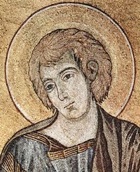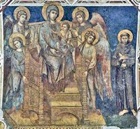
Detail of mosaic (1301-2) by Cimabue
depicting St John the Evangelist
Duomo, Pisa
Cenni (Giovanni) di Pepo, Cimabue (“ox-head”) was documented in Rome in 1272. His only securely documented work was in Pisa, at the end of his life, and the only survival is the upper part of a mosaic (1301-2) of St John the Evangelist in the Duomo there.
His contemporary, Dante Alighieri refers to him in “The Divine Comedy” (Purg. xi. 94-6) in a conversation in Purgatory with the miniaturist Oderisi da Gubbio that illustrated the transitory nature of fame. Oderisi observes rather ruefully that his fame has been eclipsed by that of Franco Bolognese. He then observes: “In painting Cimabue thought the field was his alone. Now the cry is Giotto, so the fame of the other is in shadow ..”. This led later writers, including Giorgio Vasari, to cast Cimabue as Giotto’s teacher.
The attribution of other works to Cimabue starts with the Maestà (ca. 1285) from Santa Trinità, Florence (Uffizi Gallery, Florence). This seems to pre-date the work attributed to him in San Franceso, Assisi.
San Franceso, Assisi
A number of frescoes in San Franceso, Assisi are attributed to Cimabue:
-
✴a number of frescoes (ca. 1278) in the apse and transepts and in the vaults of the crossing of the Upper Church.

The dating of this work and its historical context are discussed in the page on San Francesco in the period 1253-1300.
Cimabue’s Influence in Umbria

-
✴the fresco (late 13th century) in the refectory of the nunnery of Santa Giuliana, Perugia, which is attributed to the Maestro del Trittico Marzolini;
-
✴the central panel of a triptych (early 14th century) from Santa Maria della Stella, Spoleto that is attributed to the Maestro di Cesi, which is now in the Villa Ephrussi de Rothschild, Saint-Jean-Cap-Ferrat, France;
-
✴the fresco (14th century) of the Assumption of the Virgin in the nuns’ choir of Santa Maria di Monteluce, Perugia.




